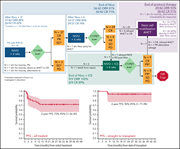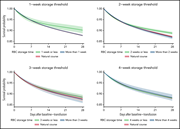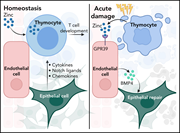Issue Archive
Table of Contents
EDITORIAL
Introduction to a review series on immunotherapies for nonmalignant hematologic diseases
Clinical Trials & Observations
This Review Series, edited by past Associate Editor Catherine Bollard, looks at the role of immunotherapy in nonmalignant hematologic diseases. These 3 state-of-the-art reviews focus on the role of complement and complement inhibitors across a spectrum of diseases, the special immunologic challenges of hematopoietic stem cell transplant for nonmalignant diseases where patients have an intact immune system, and the hematologic complications of immune checkpoint inhibitors.
BLOOD COMMENTARIES
REVIEW SERIES
Advancing therapeutic complement inhibition in hematologic diseases: PNH and beyond
This Review Series, edited by past Associate Editor Catherine Bollard, looks at the role of immunotherapy in nonmalignant hematologic diseases. These 3 state-of-the-art reviews focus on the role of complement and complement inhibitors across a spectrum of diseases, the special immunologic challenges of hematopoietic stem cell transplant for nonmalignant diseases where patients have an intact immune system, and the hematologic complications of immune checkpoint inhibitors.
Emerging approaches to improve allogeneic hematopoietic cell transplantation outcomes for nonmalignant diseases
This Review Series, edited by past Associate Editor Catherine Bollard, looks at the role of immunotherapy in nonmalignant hematologic diseases. These 3 state-of-the-art reviews focus on the role of complement and complement inhibitors across a spectrum of diseases, the special immunologic challenges of hematopoietic stem cell transplant for nonmalignant diseases where patients have an intact immune system, and the hematologic complications of immune checkpoint inhibitors.
Hematologic complications of immune checkpoint inhibitors
This Review Series, edited by past Associate Editor Catherine Bollard, looks at the role of immunotherapy in nonmalignant hematologic diseases. These 3 state-of-the-art reviews focus on the role of complement and complement inhibitors across a spectrum of diseases, the special immunologic challenges of hematopoietic stem cell transplant for nonmalignant diseases where patients have an intact immune system, and the hematologic complications of immune checkpoint inhibitors.
CLINICAL TRIALS AND OBSERVATIONS
Response-adapted anti-PD-1–based salvage therapy for Hodgkin lymphoma with nivolumab alone or in combination with ICE
Clinical Trials & Observations
Mei and colleagues report on the results of positron emission tomography PET–adapted nivolumab (NIVO) alone or in combination with chemotherapy as first salvage therapy and bridge to autologous transplantation (ASCT) in 43 patients with relapsed/refractory Hodgkin lymphoma. Patients in complete remission by PET after 3 doses of NIVO went directly to ASCT; the remaining patients received salvage chemotherapy as a bridge to ASCT. Two-year progression–free survival (PFS) was 72% overall, with PFS of 95% of those who bridged directly to ASCT after NIVO.
LYMPHOID NEOPLASIA
Extracellular vesicles and PD-L1 suppress macrophages, inducing therapy resistance in TP53-deficient B-cell malignancies
Izquierdo and colleagues elucidate the mechanism of chemoimmunotherapy (CIT) resistance in B-cell malignancies with TP53 loss. They demonstrate that TP53 loss interferes in the crosstalk between tumor cells and macrophages by the upregulation of PD-L1 expression on the tumor cell surface and on secreted extracellular vesicles, leading to suppression of phagocytosis. Disruption of PD-L1 expression by antibodies or PD-L1 knockout improves phagocytosis and response to CIT.
MYELOID NEOPLASIA
BMP2/SMAD pathway activation in JAK2/p53-mutant megakaryocyte/erythroid progenitors promotes leukemic transformation
Leukemic transformation of myeloproliferative neoplasms (MPN) has a poor prognosis and is commonly associated with mutational inactivation of TP53. Li and colleagues demonstrate in mouse models and in primary cells that biallelic TP53 inactivation in the presence of JAK2V617F induces erythroleukemia associated with aberrant activation of the BMP2/SMAD pathway, recurrent copy number alterations, and DNA damage. These observations provide entry points for novel approaches to this lethal complication of MPN.
TRANSFUSION MEDICINE
Intervening on the storage time of RBC units and its effects on adverse recipient outcomes using real-world data
Clinical Trials & Observations
Many randomized controlled trials have failed to confirm that red blood cell (RBC) age affects patient survival. Positing weaknesses in the design of such trials, Bruun-Rasmussen et al used modeling of hypothetical trials using real-world data from a Danish national database, including 89,000 patients receiving transfusion with a 28-day follow-up. These statistically-derived data suggest an increased risk of thromboembolism or death with transfusion of exclusively older RBC units.
TRANSPLANTATION
Activation of the zinc-sensing receptor GPR39 promotes T-cell reconstitution after hematopoietic cell transplant in mice
Immune reconstitution after hematopoietic stem cell transplant (HSCT) depends on thymic regeneration, a capacity that attenuates with age. Zinc has previously been shown to be important for normal T-cell development, but Iovino et al demonstrate a complex role for zinc in thymic repair following injury in mice. Zinc is released into the extracellular thymic milieu after HSCT conditioning, where it stimulates endothelial cell BMP4 release and thymic epithelial regeneration. The role of zinc supplementation in clinical HSCT remains to be investigated.
BLOOD WORK
ERRATA
-
Cover Image
Cover Image
![issue cover]()
Confocal imaging of DiD-labeled extracellular vesicles (EVs; red) derived from double-hit B-cell lymphoma cells incubated with GFP+J774A.1 macrophages (green), showing intracellular uptake of EVs by macrophages. See the article by Izquierdo et al on page 3617.
- PDF Icon Front MatterFront Matter
- PDF Icon Table of ContentsTable of Contents
- PDF Icon Editorial BoardEditorial Board
Advertisement intended for health care professionals
Email alerts
Advertisement intended for health care professionals











Smart salvage treatment for Hodgkin lymphoma
Clinical Trials & Observations